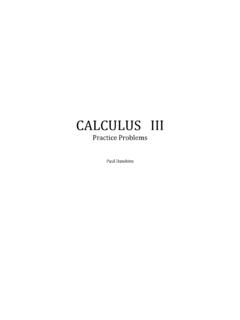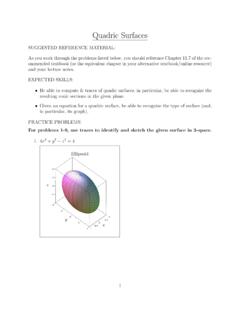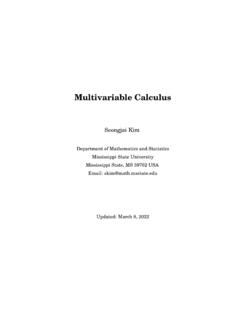Transcription of B. Tech. Syllabus
1 KERALA TECHNOLOGICAL UNIVERSITY. B. Tech. Syllabus KERALA TECHNOLOGICAL UNIVERSITY. Syllabus for I & II Semester B. Tech. Degree 2015. as on Kerala Technological University CET Campus, Thiruvananthapuram Kerala -695016 India Phone +91 471 2598122, 2598422. Fax +91 471 2598522. Web: Email: Table of Contents Code Subject Page MA 101 Calculus 2. PH 100 Engineering Physics 5. CY 100 Engineering Chemistry 8. BE 100 Engineering Mechanics 10. BE 110 Engineering Graphics 12. BE 101-01 Introduction to Civil Engineering 15. BE 101-02 Introduction to Mechanical Engineering Sciences 17. BE 101-03 Introduction to Electrical Engineering 20. BE 101-04 Introduction to Electronics Engineering 22. BE 101-05 Introduction to Computing and Problem Solving 24. BE 101-06 Introduction to Chemical Engineering 28. BE 103 Introduction to Sustainable Engineering 30.
2 CE 100 Basics of Civil Engineering 33. ME 100 Basics of Mechanical Engineering 36. EE 100 Basics of Electrical Engineering 38. EC 100 Basics of Electronics Engineering 40. MA102 Differential Equations 42. BE 102 Design and Engineering 45. PH 110 Engineering Physics Lab 48. CY 110 Engineering Chemistry Lab 50. CE 110 Civil Engineering Workshop 51. ME 110 Mechanical Engineering Workshop 53. EE 110 Electrical Engineering Workshop 54. EC 110 Electronics Engineering Workshop 55. CS 110 Computer Science Workshop 57. CH 110 Chemical Engineering Workshop 59. 1. Course No. Course Name L-T-P-Credits Year of Introduction MA101 CALCULUS 3-1-0-4 2015. Course Objectives In this course the students are introduced to some basic tools in Mathematics which are useful in modelling and analysing physical phenomena involving continuous changes of variables or parameters.
3 The differential and integral calculus of functions of one or more variables and of vector functions taught in this course have applications across all branches of engineering. This course will also provide basic training in plotting and visualising graphs of functions and intuitively understanding their properties using appropriate software packages. Syllabus Single Variable Calculus and Infinite series, Three dimensional space and functions of more than one variable, Partial derivatives and its applications, Calculus of vector valued functions, Multiple Integrals, Vector Integration. Expected outcome At the end of the course the student will be able to model physical phenomena involving continuous changes of variables and parameters and will also have acquired basic training in visualising graphs and surfaces using software or otherwise.
4 Text Book: Anton, Bivens and Davis, Calculus, John Wiley and Sons. Pal, S. and Bhunia, S. C., Engineering Mathematics, Oxford University Press, 2015. Thomas Jr., G. B., Weir, M. D. and Hass, J. R., Thomas' Calculus, Pearson. References: Bali, N. P. and Goyal, M., Engineering Mathematics, Lakshmy Publications. Grewal, B. S., Higher Engineering Mathematics, Khanna Publishers, New Delhi. Jordan, D. W. and Smith, P., Mathematical Techniques, Oxford University Press. Kreyszig, E., Advanced Engineering Mathematics, Wiley India edition. Sengar and Singh, Advanced Calculus, Cengage Learning. Srivastava, A. C. and Srivasthava, P. K., Engineering Mathematics Vol. 1, PHI Learning Pvt. Ltd. Course Plan Module Contents Hours Sem. Exam Marks I Single Variable Calculus and Infinite series (Book I , , , , , , ). Introduction: Hyperbolic functions and inverses- 3.
5 Derivatives and integrals. 15 %. Basic ideas of infinite series and convergence. Convergence tests-comparison, ratio, root tests (without 3. proof). Absolute convergence. Maclaurins series-Taylor series - radius of convergence. 2. (For practice and submission as assignment only: Sketching, plotting and interpretation of exponential, logarithmic and hyperbolic functions using suitable 3. software. Demonstration of convergence of series by software packages). II Three dimensional space and functions of more than one variable (Book I , , , ). Three dimensional space; quadric surfaces , Rectangular, Cylindrical and spherical coordinates, Relation between coordinate systems. 4. Equation of surfaces in cylindrical and spherical coordinate systems. 15 %. Functions of two or more variables graphs of functions of two variables- level curves and surfaces Limits and 2.
6 Continuity. (For practice and submission as assignment only: Tracing of surfaces - graphing quadric surfaces - graphing 2. functions of two variables using software packages). FIRST INTERNAL EXAM. III Partial derivatives and its applications(Book I sec. to and ). Partial derivatives - Partial derivatives of functions of more than two variables - higher order partial derivatives 4 15 %. - differentiability, differentials and local linearity. The chain rule - Maxima and Minima of functions of two variables - extreme value theorem (without proof)- 5. relative extrema. IV Calculus of vector valued functions(Book , , ). Introduction to vector valued functions - parametric curves in 3-space. Limits and continuity - derivatives - 2. tangent lines - derivative of dot and cross product- definite integrals of vector valued functions. Change of parameter - arc length - unit tangent - normal 15 %.
7 - velocity - acceleration and speed - Normal and 2. tangential components of acceleration. Directional derivatives and gradients-tangent planes and 2. normal vectors. (For practice and submission as assignment only: Graphing parametric curves and surfaces using software 4. packages). 3. SECOND INTERNAL EXAM. V Multiple integrals (Book I-sec. , , , , , ). Double integrals - Evaluation of double integrals - Double integrals in non-rectangular coordinates - 3. reversing the order of integration. Area calculated as double integral - Double integrals in 2. polar coordinates. Triple integrals - volume calculated as a triple integral - 20 %. triple integrals in cylindrical and spherical coordinates. 2. Converting triple integrals from rectangular to cylindrical coordinates - converting triple integrals from rectangular to spherical coordinates - change of 3.
8 Variables in multiple integrals - Jacobians (applications of results only). VI Vector integration(Book I sec. , , , , , , ). Vector and scalar fields- Gradient fields conservative fields and potential functions divergence and curl - the 3. 2. operator - the Laplacian . Line integrals - work as a line integral- independence of 3. path-conservative vector field. Green's Theorem (without proof- only for simply connected region in plane), surface integrals . Divergence Theorem (without proof) , Stokes' Theorem (without proof) 20 %. (For practice and submission as assignment only: graphical representation of vector fields using software packages). 4. Green's Theorem (without proof- only for simply connected region in plane), surface integrals flux integral - Divergence Theorem (without proof) , Stokes'. Theorem (without proof). (For practice and submission as assignment only: graphical representation of vector fields using software packages ).
9 END SEMESTER EXAM. Open source software packages such as gnuplot, maxima, scilab, geogebra or R may be used as appropriate for practice and assignment problems. TUITORIALS: Tutorials can be ideally conducted by dividing each class in to two groups. Prepare necessary materials from each module that are to be taught using computer. Use it uniformly to every class. 4. Course No. Course Name L-T-P-Credits Year of Introduction PH100 ENGINEERING PHYSICS 3-1-0-4 2015. Course Objectives Most of the engineering disciplines are rooted in Physics. In fact a good engineer is more or less an applied physicist. This course is designed to provide a bridge to the world of technology from the basics of science and to equip the students with skills in scientific inquiry, problem solving, and laboratory techniques. Syllabus Harmonic Oscillations: Damped and Forced Harmonic Oscillations.
10 Waves: One Dimensional and Three Dimensional waves, Interference: Interference in thin films (Reflected system) Diffraction: Fraunhofer and Fresnel Diffraction, Grating, Polarization of Light: Double refraction, production and detection of polarized light, Superconductivity: Properties and Applications. Quantum Mechanics: Schrodinger Equations- Formulation and Solution, Operators, Applications. Statistical Mechanics: Microstates and macro states Maxwell - Boltzmann, Bose-Einstein and Fermi Dirac statistics. Fermi level and its significance. Acoustics: Intensity of sound, Reverberation and design concepts, Ultrasonics: Production, Detection and Applications, NDT methods, Lasers: Properties, Working Principles, Practical Lasers. Photonics: Basics of Solid State lighting, Photo detectors, Solar Cells, Fiber Optics. Expected outcome Familiarity with the principles of Physics and its significance in engineering systems and technological advances.




